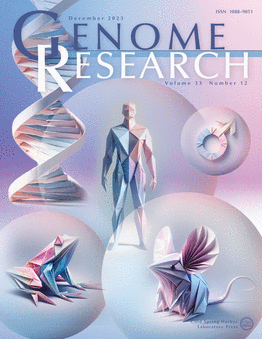Long-read genomics reveal extensive nuclear-specific evolution and allele-specific expression in a dikaryotic fungus
IF 6.2
2区 生物学
Q1 BIOCHEMISTRY & MOLECULAR BIOLOGY
引用次数: 0
Abstract
Phased telomere-to-telomere (T2T) genome assemblies are revolutionizing our understanding of long-hidden genome biology dark matter such as centromeres, rDNA repeats, inter-haplotype variation, and allele-specific expression (ASE). Yet insights into dikaryotic fungi that separate their haploid genomes into distinct nuclei are limited. Here we explore the impact of dikaryotism on the genome biology of a long-term asexual clone of the wheat pathogenic fungus Puccinia striiformis f. sp. tritici. We use Oxford Nanopore Technologies (ONT) duplex sequencing combined with Hi-C to generate a T2T nuclear-phased assembly with >99.999% consensus accuracy. We show that this fungus has large regional centromeres enriched in LTR retrotransposons, with a single centromeric dip in methylation that suggests one kinetochore attachment site per chromosome. The centromeres of homologous chromosomes are most often highly diverse in sequence and kinetochore attachment sites are not always positionally conserved. Each nucleus carries a unique array of rDNAs with >200 copies that harbour nucleus-specific sequence variations. The inter-haplotype diversity between the two nuclear genomes is shaped by large-scale structural variations linked to transposable elements. ONT long-read cDNA analysis across dormancy and distinct host infection conditions revealed pervasive ASE for nearly 20% of the heterozygous genes. Genes encoding secreted proteins, including putative virulence effectors, are significantly enriched in ASE genes which appear to be linked to elevated CpG gene body methylation of the lower-expressed allele. This suggests that epigenetically regulated ASE is likely a previously overlooked mechanism facilitating plant infection. Overall, our study reveals how dikaryotism uniquely shapes key eukaryotic genome features.长读基因组学揭示了双核真菌广泛的核特异性进化和等位基因特异性表达
分阶段的端粒到端粒(T2T)基因组组装正在彻底改变我们对长期隐藏的基因组生物学暗物质的理解,如着丝粒、rDNA重复序列、单倍型间变异和等位基因特异性表达(ASE)。然而,对将单倍体基因组分离成不同细胞核的双核真菌的了解有限。在此,我们探讨了双核性对小麦致病真菌小麦纹状锈菌长期无性克隆基因组生物学的影响。我们使用Oxford Nanopore Technologies (ONT)双工测序结合Hi-C生成T2T核相组件,一致性精度为99.999%。我们发现,这种真菌具有富含LTR反转录转座子的大区域着丝粒,具有单个甲基化的着丝粒,表明每条染色体有一个着丝粒附着位点。同源染色体的着丝粒通常在序列上高度多样化,着丝粒附着位点并不总是位置保守。每个细胞核携带一组独特的rnas,有200个拷贝,其中包含细胞核特异性序列变异。两个核基因组之间的单倍型多样性是由与转座因子相关的大规模结构变化形成的。ONT长读cDNA分析在休眠和不同宿主感染条件下显示近20%的杂合基因普遍存在ASE。编码分泌蛋白的基因,包括假定的毒力效应基因,在ASE基因中显著富集,这似乎与低表达等位基因CpG基因体甲基化升高有关。这表明表观遗传调控的ASE可能是一个以前被忽视的促进植物侵染的机制。总的来说,我们的研究揭示了双核生物如何独特地塑造关键的真核生物基因组特征。
本文章由计算机程序翻译,如有差异,请以英文原文为准。
求助全文
约1分钟内获得全文
求助全文
来源期刊

Genome research
生物-生化与分子生物学
CiteScore
12.40
自引率
1.40%
发文量
140
审稿时长
6 months
期刊介绍:
Launched in 1995, Genome Research is an international, continuously published, peer-reviewed journal that focuses on research that provides novel insights into the genome biology of all organisms, including advances in genomic medicine.
Among the topics considered by the journal are genome structure and function, comparative genomics, molecular evolution, genome-scale quantitative and population genetics, proteomics, epigenomics, and systems biology. The journal also features exciting gene discoveries and reports of cutting-edge computational biology and high-throughput methodologies.
New data in these areas are published as research papers, or methods and resource reports that provide novel information on technologies or tools that will be of interest to a broad readership. Complete data sets are presented electronically on the journal''s web site where appropriate. The journal also provides Reviews, Perspectives, and Insight/Outlook articles, which present commentary on the latest advances published both here and elsewhere, placing such progress in its broader biological context.
 求助内容:
求助内容: 应助结果提醒方式:
应助结果提醒方式:


